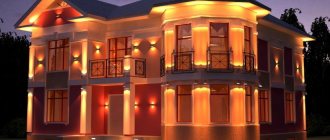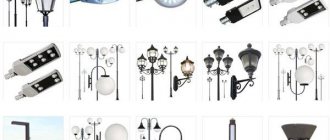Success in growing greenhouse plants largely depends on the availability of the basic factors for any crop - moisture and light. Lighting in a greenhouse, as well as timely watering, determines the development of plant cells, shoot growth, flowering and timely fruiting. But not every light is useful for seedlings; in some situations, crops may wither or produce wild shoots instead of a voluminous harvest, or the fruits may turn out to be inedible. In order to prevent damage to the vegetation in the greenhouse due to poor-quality lighting, it is worth understanding the basic rules and requirements for its arrangement.
Norms and requirements
It should be noted that all representatives of the plant world react differently to the effects of light radiation. Also, the radiation spectrum will stimulate different functions in growing crops, so you need to consider the length of the emitted waves, which lie in the ultraviolet or infrared spectrum:
- The ultraviolet spectrum from 300 to 400 nm is useful for removing harmful microorganisms from the greenhouse, but can be used exclusively for preventive purposes. Long-term exposure will be detrimental to the flora.
- Violet 400 - 430 nm - allows you to strengthen the trunk and increase resistance to external weather factors.
- Blue spectrum 440 – 460 nm – promotes the growth of both the root system and leaves, increases photosynthesis of crops grown in a greenhouse.
- Green 500 - 600 nm - has no practical benefit for the inhabitants of the greenhouse; if you install only such models of lighting devices, the entire crop may die.
- Yellow 600 – 620 nm – stimulates the elongation of plants, which is not suitable for all crops, for example, it is relevant for ornamental trees, shrubs and others. But it is useless for fruiting or flowering plants.
- Red spectrum 620 - 700 nm - under its influence, the production of carbohydrates and their further transportation are stimulated, which leads to the rapid development of fruits or peduncles.
- Infrared radiation of 780 nm or more leads to an increase in plant temperature, which can destroy the crop in the greenhouse.
The choice of a specific spectrum of lamps for artificial lighting is made in accordance with the variety of flora being grown and the desired result. In practice, lighting lamps can contain several spectra at once, which expands their functionality. But this does not apply to all lighting devices, so it is necessary to carefully study the features of the influence of lighting devices on the microclimate of the greenhouse and the condition of its inhabitants.
The influence of light on crops
LEDs
Greenhouse lighting with LEDs is becoming increasingly popular. More and more new lighting devices are appearing. The operating principle of the LED is simple.
A current is supplied to the semiconductor, which is converted into light radiation. An LED lamp is a rather complex device.
It has an optical system, a housing, and a substrate for heat removal. The only disadvantage of LEDs is their high price. For LEDs, lowering the ambient temperature does not matter.
At high temperatures, LEDs may reduce luminous output. Their resource decreases until they fail.
Choosing the type of lamps for greenhouse lighting
The modern lighting equipment market provides a fairly wide selection of lamp models that differ in operating principles. Therefore, before you start organizing lighting in a greenhouse, you must understand the feasibility of using a specific type.
Incandescent lamps
Incandescent lamps
are the cheapest option for lighting devices, but their use in greenhouses is extremely impractical. Firstly, the range of incandescent lamps will be appropriate only at the stage of weight gain. Secondly, a huge percentage of the energy consumed will be spent on heat generation, which is appropriate for heating the greenhouse. Thirdly, the temperature from incandescent lamps can destroy polycarbonate greenhouses and can even leave burns on seedlings. They also have low light output - about 5 - 8 Lm/W.
Sodium
Sodium lamps
Sodium lamps have much better light output than Ilyich bulbs, ranging from 80 to 130 Lm/W, which is much more economical. However, the temperature of the inner tube in them reaches 1300°C, and the outer flask freely heats up to 400°C, so lighting based on sodium devices must be calculated taking into account the distance to the shoots. Also, one of the disadvantages is that there is only one light spectrum suitable for the fruiting process.
Mercury
Mercury lamps
Mercury lamps do not emit as much light as sodium lamps. And the release of light occurs due to the ionization of mercury vapor, which, in the event of depressurization of the flask, will instantly end up in the surrounding space, which will have an extremely adverse effect on the condition of the plants and the suitability of further consumption of their fruits. The advantages of mercury lamps include ease of installation and good performance parameters.
Metal halide
Metal halide
They have a good luminescence spectrum among gas discharge lamps; they have proven themselves at the stage of growing seedlings, when the crops in the greenhouse develop and enter the stage of active growth.
Significant disadvantages of metal halide lighting devices for greenhouses are:
- high cost;
- influence of voltage quality on light transmission;
- quick failure in case of violation of connection conditions.
LED
LED lamps have excellent light output - in the range of 80 - 120 Lm/W, and they are also capable of producing any range of the spectrum, depending on the crystals installed in them. Many manufacturers combine several red, blue or yellow LEDs within a single lamp module. This step makes the LED lamp in the greenhouse universal, both for seed germination and for their further development and fruiting.
LED lightening
A significant advantage is good luminous power and luminous flux intensity with low power consumption. Also, LED lamps are not afraid of depressurization of the bulb and are capable of shining for about 30,000 hours. The only drawback for them is the relatively high price, but it more than pays for itself over the years of operation.
Halogen
Halogen lamps
are a type of gas-discharge lamps containing bromine and iodine vapors in a bulb. They are characterized by a monochrome glow, acceptable for local lighting of a greenhouse; the spectrum is as close as possible to sunlight. However, halogen lamps are afraid of direct touch with hands and droplets of moisture getting on them, so such lighting devices require additional protection during installation and during operation. They are characterized by a short service life, but also low cost.
Luminescent
Fluorescent lamps
are distinguished by good light output - in the range of 25 - 50 Lm/W and a long service life, in comparison with incandescent lamps. Fluorescent lamps have a suitable spectrum for growing seedlings and strengthening shoots. The disadvantage of this lighting device is the gas-filled tube containing mercury vapor, the interaction of which with plants is extremely undesirable.
LED efficiency
From high school physics classes we know that white light can be broken down into three primary colors: red, green and blue.
All plants on earth are green because they absorb all colors except green. Plants do not need green color for photosynthesis.
Why is the butterfly in the meadow yellow? Butterfly wings made of white sunlight absorb blue light and reflect red and green. They mix and give yellow color. White plants reflect the green we see, while red and blue absorb.
Red and blue colors mix to create purple. That's why LED lights shine with such a ghostly purple color. But it is precisely what plants need most.
Color Chart
The design of the LED is such that it can, under the influence of an electric current, emit light in advance of a given wave. There is no unnecessary green color in LED lamps, no infrared and ultraviolet components harmful to plants. All the light that LED lights provide is absorbed by the plants. Therefore, today there are no more effective lamps for illuminating plants than LED ones.
Features of lighting for different types of greenhouses
In addition, take into account the design features and materials of the greenhouse, since the result of lighting crops in them depends on this. The most popular in use are polycarbonate models made of translucent materials or solid buildings.
Polycarbonate
An important factor in polycarbonate greenhouses is the presence of natural light entering from the sun during the daytime.
Thanks to the presence of transparent walls and roof, you can save a significant percentage of the electricity consumed for lamps. However, the conditions for maintaining such greenhouses have a number of important nuances:
- At the installation stage of the greenhouse, take into account its orientation relative to the cardinal points and other buildings on the site in such a way as to obtain the maximum duration of illumination from the sun.
- During operation, wash the polycarbonate greenhouse in spring and autumn. It is advisable to use a disinfectant mixture to prevent the development of moss, lichens and other flora that impair the penetration of natural light.
- The installation of lamps should be done in such a way that their design does not cast a shadow on the seedlings, while at the same time providing uniform lighting over the entire area.
- Place foil or other reflective elements around the perimeter of the greenhouse that will increase the intensity of light near the ground. Try to avoid absorbent surfaces.
Industrial
Due to the complete absence of natural light, the intensity of illumination by lamps should provide the daily norm for the inhabitants of the greenhouse. Therefore, here you will definitely need different options for lighting devices; for example, infrared lamps are well combined with sodium lamps. Do not forget that in addition to lighting, in industrial buildings it is also necessary to provide crop heating, which can also be obtained from lighting equipment. Periodically, lighting is combined with ventilation of the space to prevent the formation of mold or mildew, which will certainly arise in the absence of sunlight.
Nuances of greenhouse lighting
When choosing and arranging lighting in a greenhouse, you also need to take into account the factor of periods that change daily or annually. This will allow you to build an effective plant growing system.
in winter
With the onset of cold weather, the length of daylight hours decreases, which reduces the intensity of radiation from the natural source. At this time, the greenhouse is illuminated with lamps, practically ignoring the sun's rays; for crops in a winter greenhouse, the day length is calculated to be at least 12 hours. This is especially true when growing cucumbers, nightshades, peppers and pumpkins. But for tomatoes, carrots, beets and others, the duration of lighting should be increased to 13 - 14 hours.
At night
If you supplement daylight, lamps can be used effectively at night. Such lighting is turned on in cloudy weather, when the plants did not receive enough light during the day, or when there is a technical need to take a break from the operation of the equipment. In the case of daily night lighting, the process can be automated by using timers or time relays.
Types of artificial light
This is the lighting of greenhouses for growing crops using special lamps to provide the right amount of light. When using such illumination, one cannot do without energy, which has a density of no more than 1000 mmol/m2. Lighting has the ability to supply light rays photoperiodically. Such light is used at dusk, when it is necessary to extend the night time by artificial means.
Using such lighting lamps for greenhouses, you can speed up or slow down the flowering period. With such light, minimal energy doses are used, the composition of which is no more than 10 mmol/m2.
If you do not adhere to such light rules for the growth of crops, then incomprehensible moments may occur, for example, vegetative crops may grow quickly, but not bloom, vegetables, like in a flowerbed, may bloom, but not produce the expected fruits. This sometimes happens when planting potatoes in the shade of plants, when the stems grow as much as possible, but not the root crops.
Wiring Tips
To organize lighting in a greenhouse, be sure to use the advice of experienced specialists:
- Before you start installing lamps, be sure to plan the location and the required quantity;
- the housing of the lighting equipment in the greenhouse must be connected to protective grounding in accordance with clause 1.7.51 of the PUE ;
- all wire connection points are fixed by soldering, crimping or clamping in accordance with the requirements of clause 2.1.21 of the PUE ;
- At the entrance to the greenhouse, install a shield and equip it with a protection system against overloads and emergency modes;
- When mounting lamps in polycarbonate greenhouses, use special stands or frames.
DIY electrification
Even a novice in the electrical field can handle this type of work. Run a cable underground or overhead from the house's distribution box to the greenhouse.
For underground installation, observe the following requirements:
- depth of at least 0.8 meters;
- the wire is protected by a corrugated tube or hidden inside the box;
- the trench does not intersect with the drainage system.
When laying overhead, make sure that electrical wires do not pass through branches or touch them in strong gusts of wind. After running the cable into the greenhouse, all that remains is to carry out internal wiring to the points where sockets and switches are installed. Follow the recommendations when calculating the cable cross-section.
Owners of winter greenhouses should understand that experience with crops is only half the battle. The remaining 50% of success depends on the external design and quality equipment, including lighting. Only with the combination of these aspects will it be possible to achieve a positive result and reap a large harvest.
List of used literature
- N. Kostina-Cassanelli “Secrets of the early harvest. All about greenhouses, greenhouses and seed preparation" 2017
- Gavrilenko A. P. “LED light for greenhouses” 2016
- Ktitorov A.F. “Practical guide to installing electric lighting” 1990
- V.M. Zhabtsev “The Big Book of Electricians” 2017
- G.M. Knorring, I.M. Fadin, V.N. Sidorov “Reference book for the design of electric lighting” 2010
- M.Yu. Chernichkin “All about electrics. Modern illustrated encyclopedia" 2016











